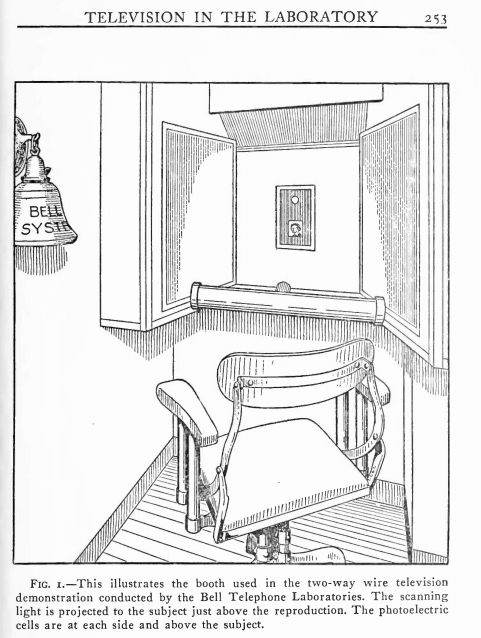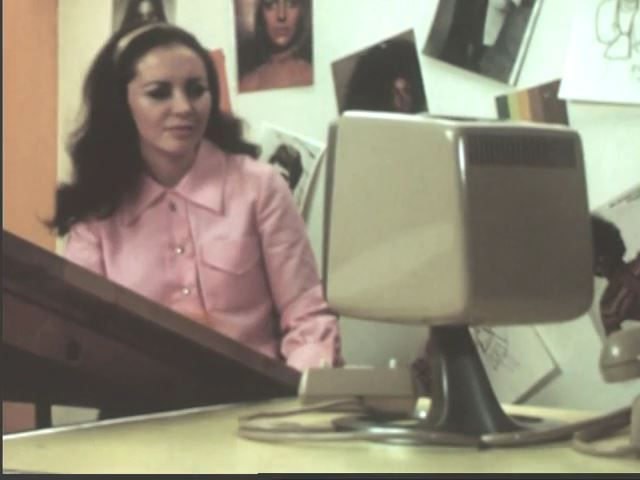Wednesday, July 10, 2019
Why did the videophone take so long?
I've asked the Y-long question about sound recording. Edison's first phonograph was equally usable as recorder and player. The office version (Dictaphone) remained record-play, but the home version instantly became play only. Why did home recording take so long to return? The answer is that home recording never returned. We have the tech built into cell phones and computers, but we still don't feel the need to record our own voices.
Similar question about the videophone.
Here's a 1930 experimental setup by Bell, found in the 1933 Arnold book that also prophesied a horrible TV utopia.
 It was fully operational with two-way sound and two-way video, not needing a transmit/receive switch, as described in Arnold's incomprehensible grammarrhoid "English":
It was fully operational with two-way sound and two-way video, not needing a transmit/receive switch, as described in Arnold's incomprehensible grammarrhoid "English":
 Hmm. The 1960's version looks a lot like a desktop computer. Why didn't the desktop computer evolve from the videophone? Why didn't the videophone become popular until 2000?
Same answer. Most people STILL don't use their cellphones as videophones. They use cellphones in two distinct ways. Most of the time it's an interactive TV or videogame system, communicating via text like a telegraph or a desktop computer. When people use it as a phone, they hold it to their head like an old-fashioned phone.
(I've never owned or handled a cellphone, so I'm just observing what others do.)
People don't like to record their own voice, and people don't like to show their face when talking on the phone. Both technologies have been available and rarely used since 1930, because human preferences haven't changed.
Hmm. The 1960's version looks a lot like a desktop computer. Why didn't the desktop computer evolve from the videophone? Why didn't the videophone become popular until 2000?
Same answer. Most people STILL don't use their cellphones as videophones. They use cellphones in two distinct ways. Most of the time it's an interactive TV or videogame system, communicating via text like a telegraph or a desktop computer. When people use it as a phone, they hold it to their head like an old-fashioned phone.
(I've never owned or handled a cellphone, so I'm just observing what others do.)
People don't like to record their own voice, and people don't like to show their face when talking on the phone. Both technologies have been available and rarely used since 1930, because human preferences haven't changed.
 It was fully operational with two-way sound and two-way video, not needing a transmit/receive switch, as described in Arnold's incomprehensible grammarrhoid "English":
It was fully operational with two-way sound and two-way video, not needing a transmit/receive switch, as described in Arnold's incomprehensible grammarrhoid "English":
In one of these television-telephone booths a person seats himself before a frame in which he will see the face of the person with whom he is talking. His own face is rapidly scanned by a mild beam of blue light which reflects from his face to the photoelectric cells and gives rise to the current which transmits his image to the distant booth. There is no fierce glare to the scanning beam; and one is not annoyed by its presence and may even gaze directly at it without inconvenience. The first thing which strikes the observer when he steps into the booth, which is lighted with a dim orange light to which the photoelectric cells are insensitive, is the absence of the usual telephone. Special telephone transmitters and receivers are concealed in the booths. One talks face to face to the distant person, and a hidden receiver speaks the words which seem to issue from his mouth.And here's the more familiar 1960's videophone, proudly exhibited by Bell in several World's Fairs:
 Hmm. The 1960's version looks a lot like a desktop computer. Why didn't the desktop computer evolve from the videophone? Why didn't the videophone become popular until 2000?
Same answer. Most people STILL don't use their cellphones as videophones. They use cellphones in two distinct ways. Most of the time it's an interactive TV or videogame system, communicating via text like a telegraph or a desktop computer. When people use it as a phone, they hold it to their head like an old-fashioned phone.
(I've never owned or handled a cellphone, so I'm just observing what others do.)
People don't like to record their own voice, and people don't like to show their face when talking on the phone. Both technologies have been available and rarely used since 1930, because human preferences haven't changed.
Hmm. The 1960's version looks a lot like a desktop computer. Why didn't the desktop computer evolve from the videophone? Why didn't the videophone become popular until 2000?
Same answer. Most people STILL don't use their cellphones as videophones. They use cellphones in two distinct ways. Most of the time it's an interactive TV or videogame system, communicating via text like a telegraph or a desktop computer. When people use it as a phone, they hold it to their head like an old-fashioned phone.
(I've never owned or handled a cellphone, so I'm just observing what others do.)
People don't like to record their own voice, and people don't like to show their face when talking on the phone. Both technologies have been available and rarely used since 1930, because human preferences haven't changed.
Labels: Asked and partly answered
